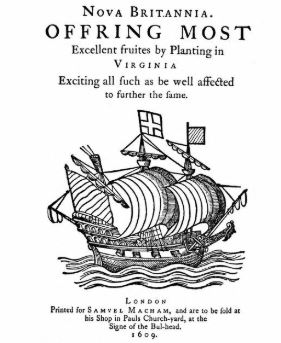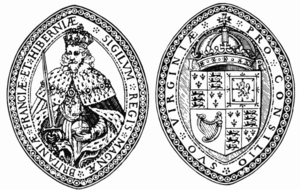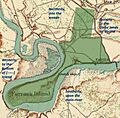William Farrar (settler) facts for kids
Quick facts for kids
William Farrar
|
|
|---|---|
| Born | April 1583 Croxton, England
|
| Died | c. 1637 |
| Occupation | Councillor - Council of Virginia and Virginia General Assembly |
| Spouse(s) | Cecily Jordan |
William Farrar (born April 1583 – died around 1637) was an important landowner and politician in early Virginia. He moved to the colony from England in 1618. He was part of the Virginia Company, which helped set up the colony. After surviving a big attack in 1622, he moved to a place called Jordan's Journey. He later married Cecily Jordan.
In 1626, Farrar became a member of the Council of Virginia. This group advised the royal governor and acted as the colony's highest court. He also served in the Virginia General Assembly. Farrar helped represent the interests of the early settlers. He was also a local judge for the upper James River area.
Farrar was on the Council when they arrested Governor John Harvey. They forced Harvey to return to England for a while. By the time Farrar died around 1637, he had sold his property in England. He had also gained rights to a large piece of land in Virginia. This land was about 2000 acres on Farrar's Island.
Contents
Early Life and Education
William Farrar was born in Croxton, Lincolnshire, England. He was christened on April 28, 1583. He was the third son of John Farrar, a wealthy merchant and landowner. His mother was Cecily Kelke, who was related to Edward III of England. Historians believe William Farrar studied law while in England.

Moving to the New World
When Farrar came to Virginia, the colony was run by the Virginia Company of London. This was a company that had permission from the King to set up colonies. Farrar bought three shares in the company. This cost him £37 10s, which was a lot of money back then.
Farrar had family connections to the Virginia Company. Two of his cousins, John Ferrar and Nicholas Ferrar, helped manage the company.
Journey to Virginia
Farrar left London on a ship called Neptune in March 1618. He traveled with Virginia's governor, Baron De La Warr. The governor was supposed to bring new people and supplies to the colony. However, De La Warr died during the trip.
When Farrar arrived in August 1618, there was confusion in Jamestown. The deputy governor, Samuel Argall, was not popular. He was accused of mismanaging the ship's passengers and cargo. Argall eventually stepped down in April 1619.
Land in the Colony
In June 1619, the Virginia Company planned to send 40 indentured servants to Farrar. Indentured servants were people who agreed to work for a set number of years in exchange for their passage to America. Paying for their travel would have given Farrar rights to 2000 acres of land. However, the ship carrying them, Garland, was damaged in a hurricane. It never reached Virginia.
Farrar did receive a land patent for 100 acres. This land was on the Appomattox River, near what is now Hopewell, Virginia. He later left this land because of a large attack by Native Americans in 1622.
Life at Jordan's Journey
During the 1622 attack, ten settlers on Farrar's land were killed. Farrar survived and found safety at Samuel Jordan's settlement. This place was called Jordan's Journey. It became a safe place for survivors after the attack.
Marriage to Cecily Jordan
Samuel Jordan died before June 1623. Sometime after, Farrar asked Jordan's widow, Cecily, to marry him. This led to the first "breach of promise" lawsuit in North America. Another man, Reverend Greville Pooley, claimed Cecily had promised to marry him first. Cecily denied this and accepted Farrar's proposal. The case lasted almost two years.
William Farrar and Cecily Jordan continued to work together at Jordan's Journey. In November 1623, Farrar was put in charge of managing Samuel Jordan's property. A year later, records show "Farrar William mr & Mrs. Jordan" sharing a household. They lived with three daughters and ten male servants. Jordan's Journey became very successful during this time.
By May 1625, William Farrar and Cecily Jordan were married. They had three children together: Cecily (born 1625), William (birth year not certain), and John (born around 1632).
Roles in the Royal Colony
On March 14, 1626, King Charles I of England appointed William Farrar to the Council of Virginia. This was a very important position. Farrar held this role until at least 1635.
Governing the Colony
Farrar became a councillor during a time of change for the colony. The Virginia Company's charter had allowed for self-governance. But King James I ended the charter in 1624. This put the colony directly under the King's control.
King Charles I wanted to be the only ruler of his colonies. He created a new government structure. It included a governor, Sir George Yeardley, and 13 councillors, including William Farrar. The Council was the only official group representing the settlers' interests. This changed in 1628 when the House of Burgesses was allowed to meet again.
The Council also acted as Virginia's highest court. It advised the governor on new laws. Council members could even decide the governor's fate. Farrar was on the Council when they elected John Pott as governor in 1628. He was also on the Council when they temporarily sent Governor Harvey away in 1635. Farrar himself questioned Governor Harvey's actions, which helped lead to Harvey's arrest.
Local Judge
In August 1626, Governor Yeardley also appointed Farrar as a commissioner. This meant he was a local judge for the "Upper Partes" along the James River. This area included Charles City and Henrico. Farrar was the head commissioner. He had the final say in judgments when he was present. He could hold monthly courts at Jordan's Journey or Shirley Hundred. When his role was renewed in 1632, the court could only meet when Farrar was there.
William Farrar was also involved in buying and selling "headrights." These were contracts that allowed settlers to gain land by paying for the transport of indentured servants from England. Farrar sold headrights to other settlers.
Farrar's Island
William Farrar died sometime before June 11, 1637. At the time, he was living in Henrico. By his death, he had gained rights to a 2000-acre land patent. This land included Dutch Gap and the former settlement of Henrico. The land was granted because he had paid for 40 indentured servants.
After Farrar's death, the land rights were given to his oldest son, who was also named William. He was twelve years old at the time. The land was on a peninsula formed by a curve of the James River. This area became known as Farrar's Island. The island stayed with the Farrar family until it was sold in 1727.
Images for kids
-
The coat of arms of William Farrar's father, John Farrar of Croxton and London, Esquire







